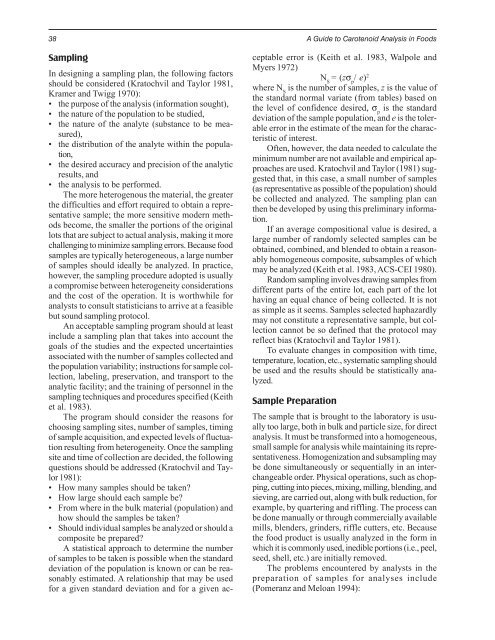A GUIDE TO CAROTENOID ANALYSIS IN FOODS
A GUIDE TO CAROTENOID ANALYSIS IN FOODS
A GUIDE TO CAROTENOID ANALYSIS IN FOODS
Create successful ePaper yourself
Turn your PDF publications into a flip-book with our unique Google optimized e-Paper software.
38 A Guide to Carotenoid Analysis in Foods<br />
Sampling<br />
In designing a sampling plan, the following factors<br />
should be considered (Kratochvil and Taylor 1981,<br />
Kramer and Twigg 1970):<br />
• the purpose of the analysis (information sought),<br />
• the nature of the population to be studied,<br />
• the nature of the analyte (substance to be measured),<br />
• the distribution of the analyte within the population,<br />
• the desired accuracy and precision of the analytic<br />
results, and<br />
• the analysis to be performed.<br />
The more heterogenous the material, the greater<br />
the difficulties and effort required to obtain a representative<br />
sample; the more sensitive modern methods<br />
become, the smaller the portions of the original<br />
lots that are subject to actual analysis, making it more<br />
challenging to minimize sampling errors. Because food<br />
samples are typically heterogeneous, a large number<br />
of samples should ideally be analyzed. In practice,<br />
however, the sampling procedure adopted is usually<br />
a compromise between heterogeneity considerations<br />
and the cost of the operation. It is worthwhile for<br />
analysts to consult statisticians to arrive at a feasible<br />
but sound sampling protocol.<br />
An acceptable sampling program should at least<br />
include a sampling plan that takes into account the<br />
goals of the studies and the expected uncertainties<br />
associated with the number of samples collected and<br />
the population variability; instructions for sample collection,<br />
labeling, preservation, and transport to the<br />
analytic facility; and the training of personnel in the<br />
sampling techniques and procedures specified (Keith<br />
et al. 1983).<br />
The program should consider the reasons for<br />
choosing sampling sites, number of samples, timing<br />
of sample acquisition, and expected levels of fluctuation<br />
resulting from heterogeneity. Once the sampling<br />
site and time of collection are decided, the following<br />
questions should be addressed (Kratochvil and Taylor<br />
1981):<br />
• How many samples should be taken?<br />
• How large should each sample be?<br />
• From where in the bulk material (population) and<br />
how should the samples be taken?<br />
• Should individual samples be analyzed or should a<br />
composite be prepared?<br />
A statistical approach to determine the number<br />
of samples to be taken is possible when the standard<br />
deviation of the population is known or can be reasonably<br />
estimated. A relationship that may be used<br />
for a given standard deviation and for a given ac-<br />
ceptable error is (Keith et al. 1983, Walpole and<br />
Myers 1972)<br />
N S = (zσ p / e) 2<br />
where N S is the number of samples, z is the value of<br />
the standard normal variate (from tables) based on<br />
the level of confidence desired, σ p is the standard<br />
deviation of the sample population, and e is the tolerable<br />
error in the estimate of the mean for the characteristic<br />
of interest.<br />
Often, however, the data needed to calculate the<br />
minimum number are not available and empirical approaches<br />
are used. Kratochvil and Taylor (1981) suggested<br />
that, in this case, a small number of samples<br />
(as representative as possible of the population) should<br />
be collected and analyzed. The sampling plan can<br />
then be developed by using this preliminary information.<br />
If an average compositional value is desired, a<br />
large number of randomly selected samples can be<br />
obtained, combined, and blended to obtain a reasonably<br />
homogeneous composite, subsamples of which<br />
may be analyzed (Keith et al. 1983, ACS-CEI 1980).<br />
Random sampling involves drawing samples from<br />
different parts of the entire lot, each part of the lot<br />
having an equal chance of being collected. It is not<br />
as simple as it seems. Samples selected haphazardly<br />
may not constitute a representative sample, but collection<br />
cannot be so defined that the protocol may<br />
reflect bias (Kratochvil and Taylor 1981).<br />
To evaluate changes in composition with time,<br />
temperature, location, etc., systematic sampling should<br />
be used and the results should be statistically analyzed.<br />
Sample Preparation<br />
The sample that is brought to the laboratory is usually<br />
too large, both in bulk and particle size, for direct<br />
analysis. It must be transformed into a homogeneous,<br />
small sample for analysis while maintaining its representativeness.<br />
Homogenization and subsampling may<br />
be done simultaneously or sequentially in an interchangeable<br />
order. Physical operations, such as chopping,<br />
cutting into pieces, mixing, milling, blending, and<br />
sieving, are carried out, along with bulk reduction, for<br />
example, by quartering and riffling. The process can<br />
be done manually or through commercially available<br />
mills, blenders, grinders, riffle cutters, etc. Because<br />
the food product is usually analyzed in the form in<br />
which it is commonly used, inedible portions (i.e., peel,<br />
seed, shell, etc.) are initially removed.<br />
The problems encountered by analysts in the<br />
preparation of samples for analyses include<br />
(Pomeranz and Meloan 1994):

















